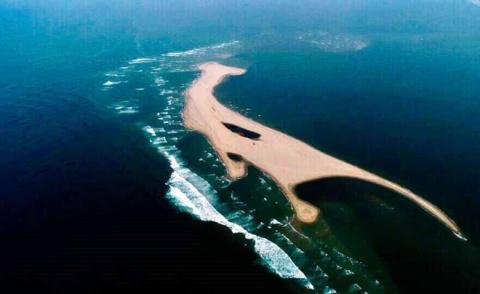The sandbank appeared at Cua Dai earlier this year, on an area of 15 hectares, 1.8 kilometers off the Cua Dai Beach.

According to Nguyen Trung Viet from the Hanoi Water Resources University, the sandbank is just the ‘tip of the iceberg’, and there must be a large sandbank underneath.
Le Tri Thanh, deputy chair of Quang Nam province, also said there is an underground sandbank, about 100 hectares in size under the visible part.
Scientists said a sandbank existed in the Cua Dai beach area about 30 years ago. In 1981-1988, one sandbank emerged north of Cua Dai beach, called Con Ang by local people. The sandbank was larger and nearer to the coastline than the newly found sandbank.
In 1989, Cecil typhoon landed in Vietnam, moving Con Ang sandbank and bringing it towards the northern coast, thus creating a floating sand bar and a semi-enclosed bay within Cua Dai.
|
Scientists said a sandbank existed in the Cua Dai beach area about 30 years ago. In 1981-1988, one sandbank emerged north of Cua Dai beach, called Con Ang by local people. The sandbank was larger and nearer to the coastline than the newly found sandbank. |
Since then, the coast complexion has changed, but an underground sandbank always existed between the northern and the southern coast of Cua Dai beach. Scientists believe this is the foundation for the newly seen sandbank.
According to Tung, this is the foundation to form a floating sand dune today. However, a question was raised why the new dune emerges from the sea since the end of 2017. Scientists think the historic flood on the Thu Bon River in November 2017 was the main cause.
Analyzing satellite images, Duong Cong Dien from the Institute of Mechanics said the formation of the ‘sand island’ is the result of the convergence and interaction between big floods on Thu Bon river, impact of the coastal wave field and hydrodynamics field of Cua Dai beach.
Therefore, Dien believes that the form of the sandbank would be unstable it tends to move towards the coast. Other scientists agree with him.
However, a lot of questions remain unanswered. Is the formation of Cua Dai alluvial ground normal or abnormal? What kinds of materials is sandbank created? Should there be any construction works to intervene in the development of the sandbank?
While scientists still disagree about the reason behind the formation of the sandbank, they share the common view that it is necessary to keep the sandbank intact instead of exploiting it.
The Dutch government has suggested building an artificial island there. However, the idea has not been applauded by Vietnamese scientists who say that the foundation of the sandbank is unstable.
RELATED NEWS
Hoi An seeks government help to protect Cua Dai Beach
Quang Nam spends over $2.2mil. to restore Cua Dai beach
Thanh Nam
 Scientists believe that erosion in the northern coast, plus the historic flood on Thu Bon River in November 2017, helped the sandbank at Cua Dai sea emerge above the sea surface. But this has not been proven." itemprop="description" />
Scientists believe that erosion in the northern coast, plus the historic flood on Thu Bon River in November 2017, helped the sandbank at Cua Dai sea emerge above the sea surface. But this has not been proven." itemprop="description" />